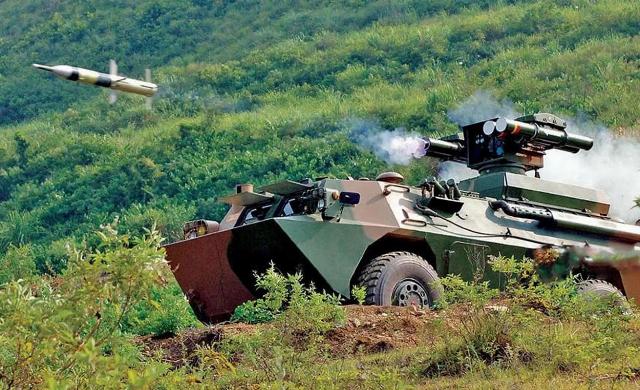Despite the ongoing modernization of anti-tank guided missiles (ATGMs) "Tow" (for more information in Part I , the US Army plans to replace it with new weapons in 2028-2032.
In 2022, the U.S. Army Office of Missile and Space Programs published a request for Proposals (RfI) with a focus on current production, production representative or prototype systems that meet the specific characteristics of a promising heavy melee missile system (Close-Combat Missile System – Heavy, CCMS-H). These characteristics include the maneuverability to engage Level 1 armored targets (defined as high-priority enemy armored vehicles) and field fortifications.
Future weapons should have dual command guidance options, which may include shot-and-forget homing, line-of-sight command guidance (CLOS) or semi-active laser homing (SAL). The weapon should also allow the crew to change targets as soon as possible in flight.
The rocket should have dimensions similar to the current TOW and be mounted in the same confined space conditions. According to RfI, "CCMS-H must maintain a minimum firing range of 65 m, a direct-fire range of 4,500 m and a range with the possibility of joint use equal to or greater than 8000 m, while maintaining a parabolic arc below 3,000 feet [914 m] above ground level (AGL)."
The missile should also fly faster than the Tow, and, as stated in the RfI, "compared to current capabilities, reduce the time of destruction at a range of up to 4,000 m." In addition, guidance signals should be received from various sources, including on-board laser designators or channels from UAVs, and the possibility of autonomous target search and guidance is desirable. It must be capable of hitting enemy vehicles equipped with active protection Systems (APS). To date, the Pentagon has not published information on the industry's response to its request, nor has a target date for submitting proposals from manufacturers been named.
Modern anti-tank guided missiles
ATGM Pars 3 LR
Over the past decade, several advanced European systems have entered the market. These include the Panzerabwehrraketensystem 3 LR (PARS 3 LR), or the third generation anti-tank guided missile system (TRIGAT-LR), manufactured by Parsys GmbH, a joint venture of MBDA Deutschland GmbH and Diehl Defense.
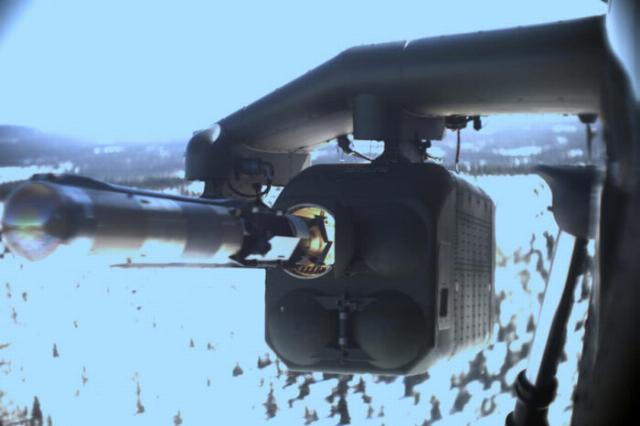
Test launch of the PARS 3 LR from a Tiger helicopter
The ATGM with infrared homing "shot-forgot" is designed exclusively for helicopter use and is equipped with a tandem warhead capable of hitting heavily armored targets at a range of up to 7 km. The helicopter platform can fire a salvo of four ATGMs in less than 10 seconds, then change position to avoid a counterattack, while the missiles are autonomously aimed at designated targets.
In the period 2012-2014, the Bundeswehr acquired 680 units for arming Tiger attack helicopters. Indonesia is currently the only export customer, with deliveries of 700 missiles starting in 2018.
ATGM Akeron MP
The Akeron MP anti-tank guided medium-range missile (formerly known as Missile Moyen Portée, MMP) manufactured by MBDA France entered service with the French Armed Forces in 2018. Although the missile was originally used as a portable infantry weapon, it is also equipped with various French armored combat vehicles purchased under the Scorpion program .
The missile has a firing range of 4 km and is equipped with a dual-band homing system with uncooled IIR cameras and daytime television, a multi-purpose tandem warhead with a choice of effects to optimize actions against armored vehicles or buildings, as well as a fiber-optic data transmission line and multi-mode guidance algorithms. Operators can choose the modes of operation "shot-forgot" or "man in the loop", the latter allows you to re-aim the missile, select a specific point of destruction or abort the mission during flight.
The missile also makes it possible to fire direct fire or along an inclined trajectory, which allows you to hit the target with an attack from above. In addition, the missile is capable of operating in two guidance modes: targeting before (LOBL) and after launch (LOAL). This flexibility allows the gunner to hit targets beyond the line of sight (LoS), for example, tanks behind shelters. The rocket uses a soft-launch system, which makes it safe to fire from a limited space. According to MBDA, the tandem cumulative fragmentation warhead is capable of piercing up to 1000 mm of rolled homogeneous armor (RHAe) or about 2000 mm of concrete.
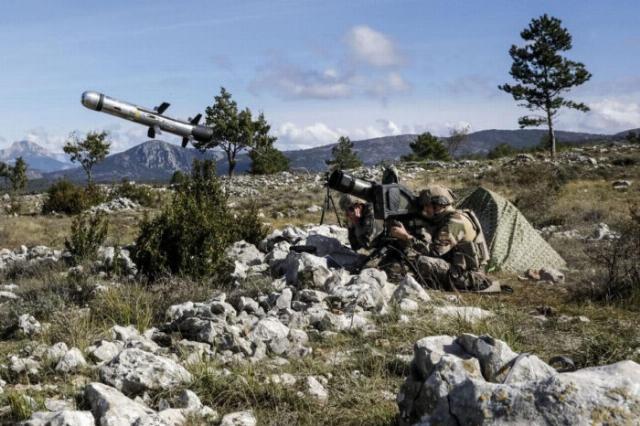
Akeron MP shooting with Visible Fiber Optic Data Line
MBDA has also developed the Akeron LP anti-tank guided missile, which will be armed with French and Spanish Tiger attack helicopters (Tiger Mk III). According to the manufacturer, it has a firing range of up to 20 km, which corresponds to the maximum range of an air launch missile. The Akeron LP ATGM is equipped with a three-mode homing head (uncooled IR, daytime television and SAL) and a bidirectional radio frequency data channel.
NLAW ATGM
Light anti-tank weapons of the next generation (Next generation Light Anti-tank Weapon, NLAW. Pronounced "EnLo"), developed by Saab. It is claimed that the product combines mobility and firepower.
Although it is not an anti-tank missile system (since the missile is not controlled in flight) [...] , the NLAW is nevertheless capable of hitting moving targets thanks to the projected line-of-sight (PLOS) guidance system. Before firing, using PLOS, the operator tracks a moving target for several seconds, and the on-board missile guidance system registers the soldier's aiming movement and autonomously calculates the required flight path.
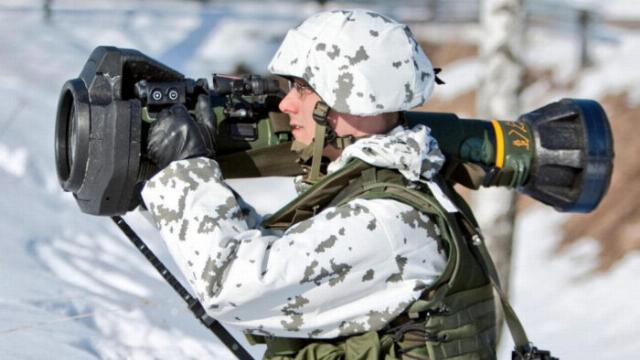
Disposable NLAW
Due to the relatively small effective range from 20 to 800 m and, consequently, the short flight time, the chances of successfully hitting the target are quite high. The user can choose the "attack from above" (OTA) mode for use against armored vehicles or the "direct attack" (DA) mode for use against structures or soft targets. In OTA mode, the warhead is powered by a dual-mode laser-magnetic contactless fuse. In the DA mode, with an impact fuse.
The maximum firing range is quite small compared to ATGMs, but with a weight of only 12.5 kg, the weapon is quite light, which allows one soldier to use it within a few seconds after detecting a target. The soft-start mechanism ensures firing from confined spaces (inside buildings). The manufacturer emphasizes that NLAW is designed to attack from almost any position, from basements to second-floor windows or roofs, which allows shooters to occupy less predictable positions.
According to Saab, the unitary warhead is capable of punching more than 500 mm of RHAe in OTA mode. This is enough to defeat MBT and other well-protected vehicles. In addition, the OTA mode allows you to fight with armored vehicles located behind shelters, such as a wall. Although the NLAW entered service in 2009, its versatility allows the weapon to remain a reliable short-range anti-tank weapon for infantry.
UMTAS ATGM
The UMTAS anti-tank guided missile (also known as ‘Mizrak-U’/‘Mizrak-U’) from the Turkish company Roketsan is designed to equip light aircraft, helicopters, UAVs, various ground vehicles and watercraft. The weapon has a maximum firing range of 8 km. To combat MBT and other heavily armored vehicles, a multi-purpose tandem warhead is equipped, and an additional thermobaric warhead is offered to destroy structures and soft targets. The UMTAS missile was certified and entered service with the Turkish Armed Forces in 2018.
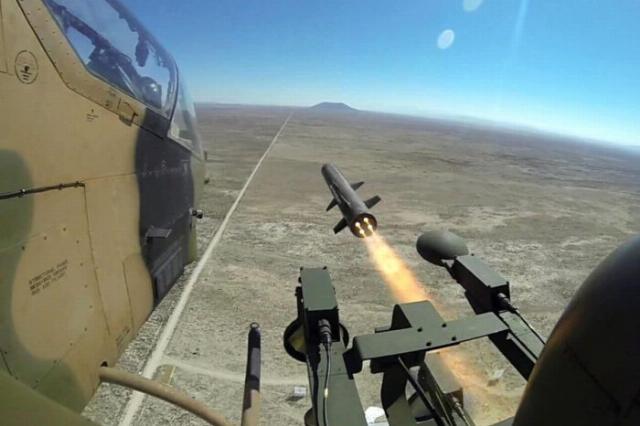
Firing a Roketsan UMTAS missile from a Turkish AH-1 attack helicopter
The basic version of the UMTAS munition is equipped with an IIR homing system, however, Roketsan has also developed a derivative version of the L-UMTAS, which is equipped with a SAL homing system. The rocket is also equipped with a radio frequency data transmission channel that provides "shot-forgot" or "man in the loop" operating modes, and the rocket is capable of operating in both LOBL and LOAL modes.
Roketsan is currently developing a variant of the future UMTAS Geleceğin Muharebe Sistemi (UMTAS-GM) combat system, the Block 1 version of which was presented in July 2023 at the IDEF exhibition in Istanbul. UMTAS-GM is slightly longer and heavier than the basic models and can be launched from ground or helicopter platforms, providing a maximum firing range of 16 km or 20 km, respectively. UMTAS-GM Block 1 is equipped with dual-mode IIR and SAL homing system. It is planned to install a dual-mode IIR and a homing system with a daytime camera on the promising Block 2 model.
The Spike family
The Spike family of anti-tank guided missiles was developed by the Israeli company Rafael Advanced Defense Systems. Production in Europe is carried out by a joint venture of EuroSpike companies Rafael, Diehl Defense and Rheinmetall. The Spike system proved to be very successful in the export market: more than 33 thousand units were sold to 33 different end users.
The ATGM family currently includes the following models in production:
- Spike SR, a shoulder-fired version with a range of 2 km;
- Spike LR 2, a version for shooting from a tripod, vehicle or helicopter with a range of 5.5 km when launched from the ground or 10 km when launched from the air;
- Spike ER2, a version for use from a vehicle or helicopter with a range of 10 km when launched from the ground or 16 km when launched from the air;
- Spike NLOS, a version for launching from a vehicle or helicopter, with a range of 32 km when launched from the ground or 50 km when launched from the air.
Technically, the family also includes the Spike Firefly, but it is more of a rotorcraft maneuverable munition than an ATGM.
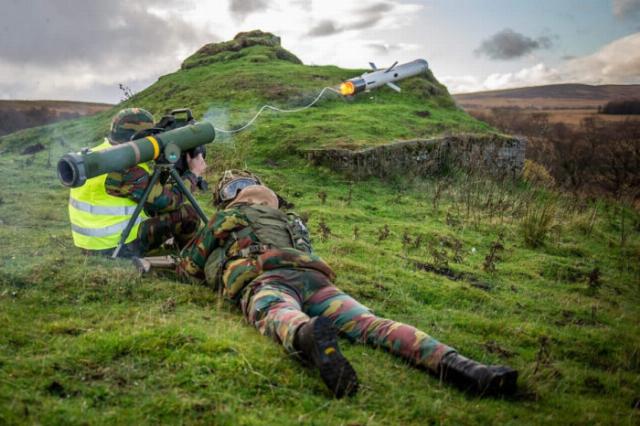
The Spike LR2 fiber optic cable is clearly visible after the rocket exits the launch container.
Perhaps the most common variant of the family is the Spike LR2, adopted both in a tripod-based configuration and mounted on a car. The missile is equipped with a dual-mode IIR and a homing system with a high-definition daytime camera. Shooting is possible in the "shot-forgot" or "man in the loop" modes. The latter is called the "shoot, watch and update" mode in Rafael. It allows the shooter to follow the flight after launching over a fiber-optic data link. In addition, the ATGM can be launched using a set of target coordinates, which allows it to be used to hit static targets such as buildings.
The missile is equipped with a tandem cumulative high explosive warhead, which is reportedly capable of piercing more than 1,000 mm of armor or attacking from above, hitting the weaker armor of the roof of vehicles.
Improved performance
In general, new anti-tank guided missiles are expanding their capabilities. Thanks to the introduction of the latest technologies, including artificial intelligence (AI), cutting-edge sensors and improved propulsion systems, ATGMs demonstrate a long range and an increasing level of automation.
If necessary, these developments will continue to overcome protective countermeasures such as electronic warfare (disruption of data transmission channels) and laser blinding of optical sensors. The ability to hit tanks from long distances and out of line of sight will become increasingly valuable for protecting ATGM calculations from return fire. The intensive use of tanks and IFVs in urban environments will also increase the demand for ATGMs capable of detecting targets in a cluttered environment.
However, the biggest challenge may be maintaining industrial capacity to ensure sufficient production in the long term. Given the rapid pace of ATGM spending, Western countries are currently experiencing difficulties replenishing stocks as soon as possible. If production capacity is not significantly expanded, NATO countries risk facing shortages in the next equal conflict.
Based on the materials of the resource euro-sd.com
